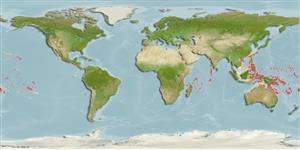Classification / Names
Common names from other countries
Main reference
Size / Weight / Age
Max length : 2.5 cm TL male/unsexed; (Ref. 9710)
Environment
Marine; reef-associated; depth range 7 - 27 m (Ref. 9710)
Climate / Range
Tropical, preferred ?; 30°N - 23°S
Distribution
Indo-Pacific: Red Sea to the Cook Islands, north to the Ryukyu Islands, south to the northern Great Barrier Reef; Guam and Kapingamarangi in Micronesia.
Countries | FAO areas | Ecosystems | Occurrences | Introductions
Short description
Dorsal
spines
(total): 5 - 9;
Dorsal
soft rays
(total): 7-9;
Anal
spines: 1;
Anal
soft rays: 8 - 9. Dorsal-fin rays VI + I,7-1,9 (usually I,8); anal-fin rays I,8 or I,9 (usually I,9); pectoral-fin rays usually 14-16; scales on body extending forward at most to below interdorsal space, the longitudinal scale series 19-40 (mean count 31); canine tooth present on side of lower jaw; head and body compressed; body depth at origin of anal fin 16-25% SL; snout usually shorter than orbit diameter; gill opening reaching to or anterior to posterior margin of orbit; caudal fin usually slightly emarginate; pelvic fins forming a shallow cup, the spines as fleshy lobes; body transparent in life, except for yellow over abdomen; interorbital and iris bright pink. Largest specimen, 19.5mm SL (Ref. 89154).
IUCN Red List Status (Ref. 115185)
Threat to humans
Harmless
Human uses
Aquarium: commercial
More information
ReferencesAquacultureAquaculture profileStrainsGeneticsAllele frequenciesHeritabilityDiseasesProcessingMass conversion
Tools
Special reports
Download XML
Internet sources
Estimates of some properties based on models
Phylogenetic diversity index
PD50 = 0.5000 many relatives (e.g. carps) 0.5 - 2.0 few relatives (e.g. lungfishes)
Trophic Level
3.1 ±0.3 se; Based on size and trophs of closest relatives
Resilience
High, minimum population doubling time less than 15 months (Preliminary K or Fecundity.)
Vulnerability
Low vulnerability (10 of 100)
Price category
